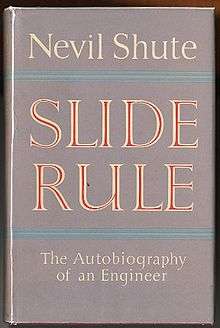Slide Rule: Autobiography of an Engineer

Slide Rule: Autobiography of an Engineer is the partial autobiography of the British novelist Nevil Shute.[1] It was first published in 1954. Slide Rule concentrates on Nevil Shute's work in aviation, ending in 1938 when he left the industry.
The book begins with details of Shute's childhood and upbringing, his school years, events in the Easter 1916 Dublin Rising, where his father was Secretary to the Post Office, and service during World War I. Shute came into contact with aircraft while a student at Oxford, when he worked at the de Havilland aircraft factory during the vacations.
The rest of the book is divided into two parts. The first is about Shute's experiences working on the R100 airship project at Vickers. This was the private counterpart to the Air Ministry's R101, both designed as part of the Imperial Airship Scheme to develop airships capable of flying the Empire routes to India, Canada and Australia. Shute's job was initially that of Chief Calculator, responsible for overseeing all the stress calculations needed. On the resignation of the airship designer, Barnes Wallis, he became the project chief engineer. He was also a passenger on the airship's flight to Canada in 1930. He recounts the experience of a mid-air repair of a rudder over the North Atlantic, and of being caught in an up-draft over a thunderhead over Canada. The R100 design was the project on which he mentions using a slide rule, a Fuller cylindrical model, only mentioned once in the book.
Shute's account of the airship development program, although seemingly objective, presents a hostile and distorted account of the R101 and says little of the problems of R100. Unfortunately his account has been taken as authoritative by many later writers on the subject.[2]
The final part of the book is about Shute's experiences in co-founding and managing Airspeed Ltd between 1931 and 1938. During this time, there was little business and much difficulty. As Shute tells it, the first time the company made a profit was in 1938, the year he resigned as a director.
Shute then spent the war as a reluctantly commissioned naval officer working for the "Wheezers and Dodgers" (the British Admiralty's Directorate of Miscellaneous Weapons Development) with time off to write a few novels, before becoming disillusioned by the post war UK government and emigrating to Australia. There his considerable success as a best selling author kept him active until he died from a heart attack in 1960. He never wrote his planned follow up to Slide Rule (which had the working title of Set Square). Much later, American Julian Smith wrote a comprehensive and somewhat controversial biography.[3]
References
- ↑ Shute, Nevil. Slide Rule: Autobiography of an Engineer. London: William Heinemann Ltd., 1954.
- ↑ Masefield, P. To Ride The Storm: The Story of the Airship R101 London, Kimber, 1982, p.204 (fn) ISBN 0 7183 0068 8
- ↑ Smith, Julian. Nevil Shute: A Biography. Oakland, New Jersey: Paper Tiger Books, 2002. ISBN 1-889439-30-4.